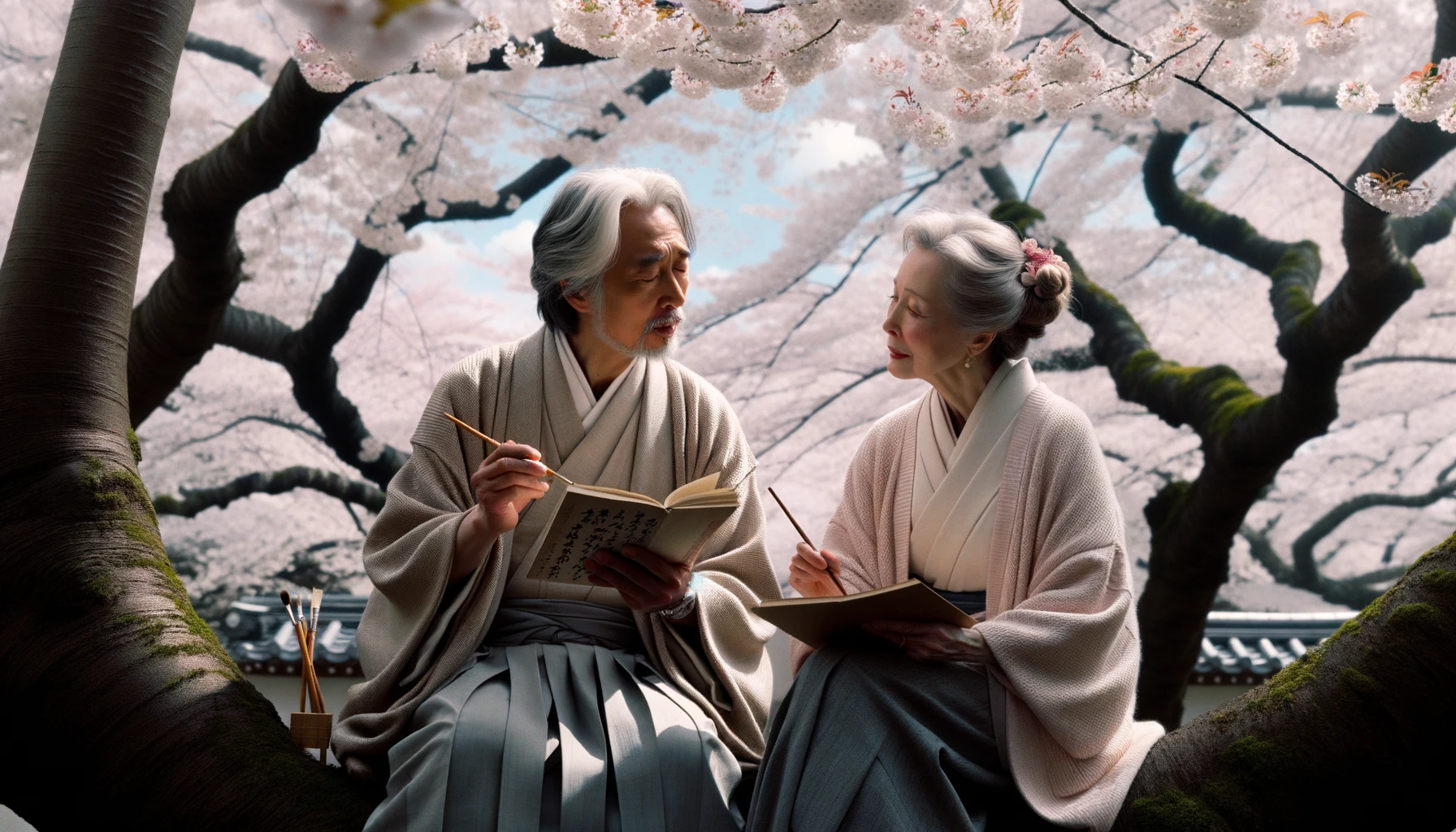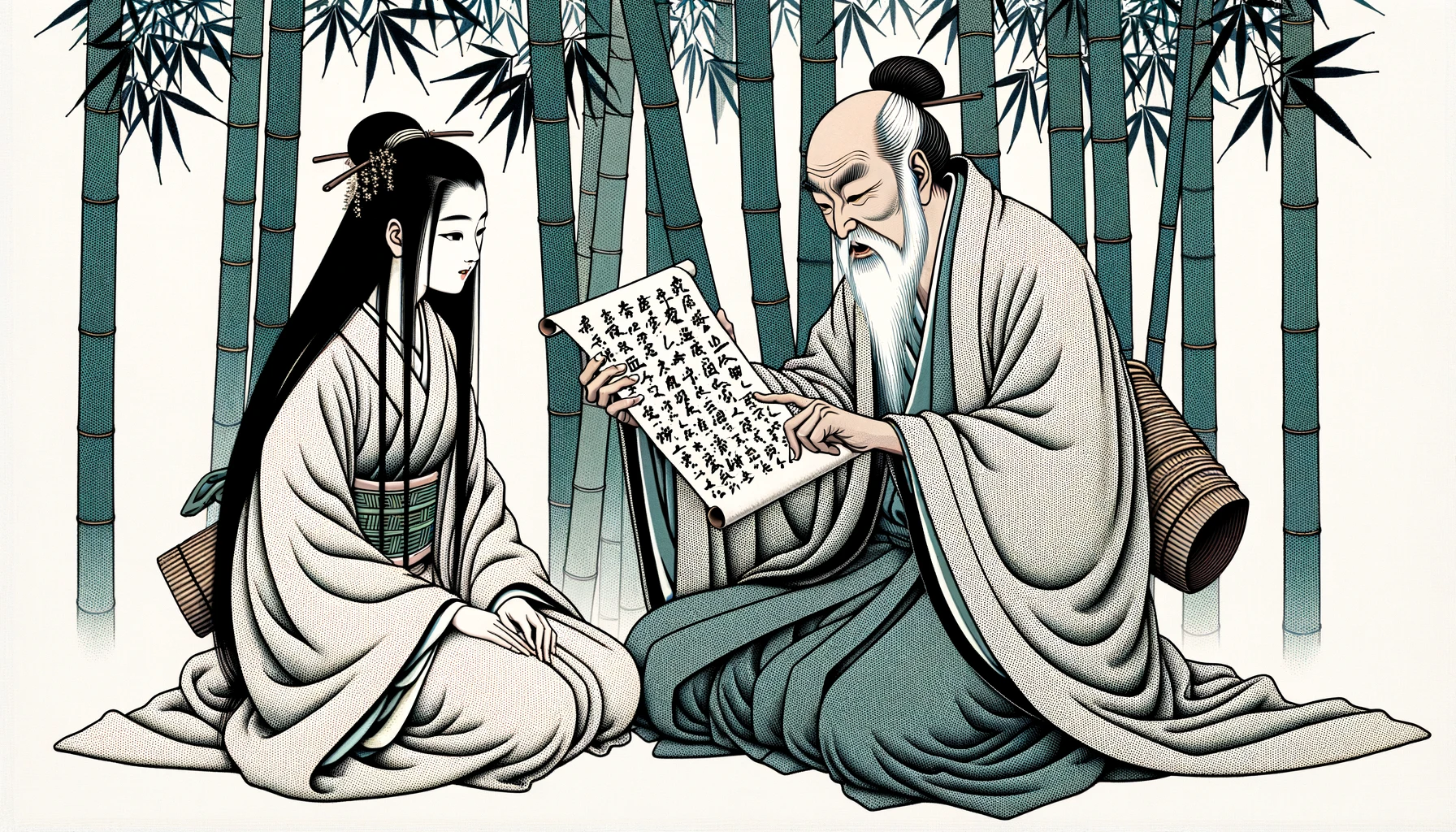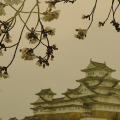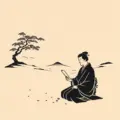At its simplest level, Renga is a collaborative form of Japanese linked poetry. Renga will typically consist of a series of short stanzas – potentially even haiku – written by multiple poets. These poets build on each other’s work, often joined together by regular or irregular linking rules – such as rhyming, the use of kireji, kigo or by an overarching theme.
Typically, a renga ends up being a long poem which is tangentially connected throughout – however, the input of many different poets leads to these poems being incredibly unpredictable. This collaboration, this give and take between various poets, results in Renga being one of the most unique and varied forms of poetry, not just in Japanese literature, but of international poetry.
The wide ranging vocabulary and use of different techniques, in addition to the potential for interplay between different “genres” (if you’ll forgive the term) of stanzas, couplets etc, or thematic paths, makes renga unpredictable in ways that a singular poet isn’t capable of – at least, not without some kind of split personality disorder.
Contents
- 1 What are the main Characteristics of Renga?
- 2 What is the History of Renga in Japanese Poetry?
- 3 Hyakuin Renga
- 4 How to Write Renga
- 5 Do Renga Poets Have Defined Roles?
- 6 What are the Potential Benefits of Collaborative Poetry?
- 7 Renga’s Influence on Free Verse
- 8 Modern Interpretations of Renga
- 9 Who Are Some Famous Renga Poets?
- 10 Conclusion
What are the main Characteristics of Renga?
The only real characteristic of renga is the contribution of many different poets to the one larger poem. Of course, there are many things which could potentially be shared across renga, but these aren’t a necessity for a poem (or series of poems, depending on your perspective) to be classified as renga.
Some of the main characteristics which you could potentially look out for include:
- Incredible variation in the stanza themselves – for example, you may see alternating long or short stanzas, depending on the poets involved, or a previously agreed upon framework which keeps each stanza to a certain rhythmic pattern, syllabic length, or some other kind of limitation.
- Linking individual verses together – traditional Japanese poets are infamous for their love of wordplay. As such, it’s likely that (particularly in traditional renga) you might see word association (potentially through Kigo), puns or other forms of wordplay conjoining each stanza to another. Of course, when you have poets contributing more than one stanza to a renga, as is often the case, you may see interlinking between the same poet’s verses throughout the larger work. To my mind, the wordplay comes more in the response of others than a repetition of one’s own thoughts, but I leave that up to your own conclusions.
- Incredibly varied and spontaneous themes – in some instances, the theme or association may not be readily apparent, resulting in a kind of “scatterbox” approach to the poem. As we know, poetry is personal and, as such, we can’t always expect to automatically make the “correct” connection between multiple pieces of conjoined work by different poets.
One thing you might also come across fairly often is a focus on humour through renga. In many cases, those involved in the renga are friends, or master and pupils. As such, trying to make the other person or people involved react positively is a common sight within modern and traditional renga.
What is the History of Renga in Japanese Poetry?
Renga originated from two older Japanese poetic forms – the short verse form tanka, and haikai no renga which linked tanka verses together in long sequences.
Tanka consists of poems with a 5-7-5-7-7 syllable structure. Haikai no renga linked tanka verses together in chains reaching 100 stanzas or more. Over several centuries, haikai no renga gradually evolved into the more codified art of renga as rules were established.
Early renga arose among aristocrats as cultured entertainment, often accompanied by lavish banquets. Renga masters like Nijō Yoshimoto set guidelines on how verses could be linked based on keywords or associated imagery.
How Has Renga Developed?
In the 15th century, renga spread from royal courts to the merchant class and common people. The unpredictable, collaborative nature of renga readings proved amusing and thought-provoking for wider audiences.
Renga underwent innovations in topic matter, verse linking and tonal variety as new schools emerged. The Danrin school emphasized simplicity and everyday language while the Sōgi school focused on creativity. Major renga poets like Sōgi and Bashō elevated the form and left a lasting impact.
For example, Sōgi’s innovative “Minase Sangin” renga sequence with 2 poets brought a wider emotional range using travel as a motif. Bashō’s “Genjuan no Shisan” took a more avant-garde approach with unconventional linking.
Haikai renga later opened up the form with fewer linking rules and an emphasis on humor. This fueled further development and even contributed to opening up the art form to what some people considered “lower poetry”, rather than the high art of traditional renga.
Today renga remains an active poetic tradition globally and continues to evolve through modern interpretations.

Hyakuin Renga
Hyakuin renga is a variant of renga consisting of 100 verses. As the name hyakuin (meaning 100 links) suggests, it follows a 100-stanza structure.
Hyakuin emerged in the late 15th century and reached peak popularity in the 16th century. It streamlined the structure of renga by fixing the length at 100 verses instead of the minimum 36 for orthodox renga.
The hyakuin form has:
- 100 verses total
- Hokku first verse
- 50 alternating 5-7-5 and 7-7 verses, meaning the first stanza has three lines of five syllables, then seven syllables, then five again, before the third stanza had two lines of seven syllables.
- Concluding 7-7 ageku verse
Hyakuin composition has similarities with orthodox renga – the hokku sets the season and rules are followed to link verses.
But the fixed length adds creative constraints. Poets must ensure coherence and avoid repetition over the 100 verses. Creativity amid restrictions became prized in hyakuin.
Major poets like Sōgi, Bōnan and Sōchō composed acclaimed hyakuin. It remains respected alongside orthodox renga as a pivotal development in linked poetry.
How Popular is Renga, as a Poetic Form?
In medieval Japan, renga was one of the most popular forms of poetry. Renga masters like Shinkei trained disciples and commoners crowded renga parties. The late master Sōgi was treated as a celebrity for his renga skill.
This popularity waned between the 17th-19th century as newer forms like haiku and waka rose to prominence instead.
How to Write Renga
If you want to write renga, the only thing you really need is someone to write with. It is a collaborative effort and, particularly today, there aren’t any further rules that you need to abide by. You could technically write renga composed entirely of haiku, rhyming couplets, free verse – anything.
There is also a school of thought, albeit not a widely accepted one, that you could write renga alone so long as you alternated perspectives within the work.

Terminology Used in Renga:
Some key terms in renga composition:
- Hokku – Opening 5-7-5 verse setting the theme
- Waki – Following 5-7-5 verses
- Daisan – 7-7 verses inbetween the waki
- Ageku – Closing 7-7 verse providing closure
Understanding the Format and Structure of Renga
Classical renga consists of at least 36 stanzas. The starting hokku is followed by alternating 5-7-5 and 7-7 verses. Renga sequences end on a 7-7 ageku providing conclusion.
Short waki verses present images while long daisan explore themes. The alternation in rhythm is key.
For example, the opening verses of Sōgi’s “Minase Sangin” renga:
Haru no yo no / yume no ukihashi / koyoi mo gare (Sōgi)
A spring night’s dream / crossing the floating bridge / this night also (Sōgi)
Kareno wo / fumiwakete yuku / samushigami (Sōchō)
Crossing the withered fields / going along / the wandering gods (Sōchō)
Here the hokku sets the spring scene, while the waki shifts to the perspective of a wandering god.
Classical Rules and Conventions in Renga
Classical renga composition has rules and linking conventions:
- Hokku sets season, which carries through
- Avoid repetition of keywords
- Link through wordplay or associated imagery
- Vary tone and perspective between verses
- Incorporate humor and surprise
For example, Bashō’s “Genjuan no Shisan” innovatively links moon and flower imagery:
Izuko to te / tsuki ya sakura no / hana to miekeri (Boncho)
As I wonder where / the moon appears as cherry blossoms (Boncho)
Waga mi wa zo / tsuki naranu toki / sakazuki kana (Bashō)
My being must have been / the moon in a previous life / cherry blossom cup! (Bashō)
However, modern renga tends to have fewer set rules and more free verse influence.
Do Renga Poets Have Defined Roles?
In classical renga, poets took on distinct responsibilities:
Recitation Leader – Composes starting hokku and oversees renga progression
Renga Master – Senior poet guiding younger participants
Renga Disciples – Apprentices learning poetry under the master’s guidance
Waki Support – Less senior poets supporting lead poets as needed
These roles created a mentorship environment. Sōgi helped train many disciples in renga principles.
Modern renga tends to have a more egalitarian participation without defined roles.
What are the Potential Benefits of Collaborative Poetry?
Collaborative renga offers many creative benefits:
- Fosters camaraderie and interplay between poets
- Allows exploration of themes greater than one mind
- Creates an unpredictable, emergent poetic process
- Provides mentoring and idea exchange
- Enables synthesis of diverse voices and styles
The communal process can inspire new directions. It also deepens poetic understanding through peer learning.
Renga’s Influence on Free Verse
Renga’s openness and linking between voices was a precursor to modern free verse poetry. Its influence spread globally in the 19th and 20th centuries.
The Imagist poets like Amy Lowell and Ezra Pound drew inspiration from the communal creative process of renga. This helped pave the way for free verse in English literature.
Modern Interpretations of Renga
Today, renga continues to evolve through modern interpretations. Contemporary poets often blend classical linking techniques and free verse innovation. Online renga connects poets worldwide into virtual linked poetry sessions.
While staying rooted in its communal origins, renga is adapted to modern contexts and individual styles. This blending of old and new maintains renga’s compelling spirit.
Who Are Some Famous Renga Poets?
Sōgi (1421-1502) – The most renowned renga master, known for creativity and rule-bending verses. Famous works include “Minase Sangin” and “Yuyama Sangin”.
Bashō (1644-1694) – The haiku master also composed avant-garde renga like “Genjuan no Shisan”. His innovative linking influence future styles.
Yamazaki Sōkan (1465-1553) – A renga poet who elevated the humorous possibilities of the form. He founded the comic haikai renga school.
Bonchō (1449-1526) – A renga master who excelled at love-themed renga. He compiled important renga anthology collections.
Moritake (1472–1549) – A leading renga figure and member of the Danrin school. He advocated accessibility over ornate diction.
These masters and others shaped renga over the centuries and demonstrated its literary heights.
Conclusion
In conclusion, renga is a fascinating poetic form that enables collaborative creativity within linking structures. Born in medieval Japan, it bridges poetry and playfulness in compelling ways. Renga’s journey over centuries and across the globe attests to the enduring power of its communal poetic spirit. Through flux and transformation, renga retains its ability to captivate imaginations.
- Glossary of Japanese Poetry Terms - 26 February 2025
- What is Waka Poetry? - 23 May 2024
- How to Identify the Kigo in a Haiku: - 22 March 2024





